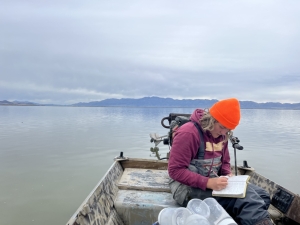PhD Student, Ecology
Utah State University
Bio:
Lauren Head is a PhD student studying Ecology at Utah State University. Her research focuses on assessing and modeling food availability for non-breeding waterbirds that use Great Salt Lake wetlands during their fall and spring migration. She is interested in modeling how changes in water level and habitat availability influence bird use on both impounded and sheetflow wetlands between seasons and years. Lauren was motivated to pursue a PhD after her time working for Utah Division of Wildlife’s Great Salt Lake Ecosystem Program, where she studied brine shrimp and waterbird populations during the record lows of the Great Salt Lake in 2021 and 2022. She is passionate about using research as an avenue to communicate the importance of Great Salt Lake wetlands and inform management actions that will help conserve the Great Salt Lake Ecosystem for future generations. Prior to moving to Utah in 2020, Lauren graduated from the University of Georgia, where she worked on multiple research projects focused on disturbance ecology in southeastern mountain and wetland ecosystems.
Title: Waterbird Bioenergetics of Impounded and Sheetflow Great Salt Lake Wetlands
Abstract: The Great Salt Lake ecosystem is facing serious and unprecedented threats due to extreme droughts and water diversions that have significantly reduced water levels in both the pelagic region and in the wetlands that follow the lake’s eastern shoreline. Millions of migratory waterfowl and shorebirds (waterbirds) rely on the diverse and abundant macroinvertebrate and vegetative foraging resources provided by the hypersaline pelagic region, as well as the extensive network of brackish and freshwater wetlands that feed into the lake. Impounded wetlands were developed by state and federal biologists as a tool to manipulate water depths and manage habitat specifically for the millions of birds that utilize these areas during the nonbreeding season, whereas surrounding non-impounded sheetflow wetlands are subject to more variable flows and habitat changes. Due to uncertainty of how drought and water diversion will continue to affect this ecosystem, there is a need for updated research on the bioenergetic value of impounded and non-impounded sheetflow wetlands around the Great Salt Lake to ensure that there are enough foraging resources to continue to support the large waterbird populations that rely on these wetlands for fall staging and overwintering. This talk will focus on current efforts to quantify food availability, habitat, and waterbird populations to construct the foundation of a bioenergetics model for nonbreeding waterbirds on Great Salt Lake wetlands.

